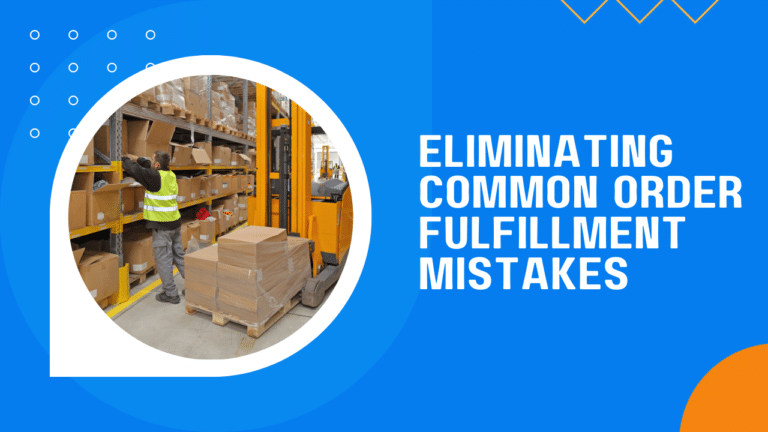If you’re running an e-commerce business, you know how important order fulfillment is for keeping your customers happy and staying ahead of the competition. Getting orders to your customers quickly and accurately is essential, but it’s not always a walk in the park. Common order fulfillment mistakes can lead to all sorts of problems, like inefficiencies, higher costs, and even a tarnished brand reputation. Yikes!
Leveraging our experience and expertise, we’ll be exploring how to eliminate common order fulfillment mistakes and streamline your supply chain, so your business runs like a well-oiled machine. We’ve got you covered with practical solutions, tips on using technology and tools to your advantage, and the benefits of getting your fulfillment game on point. So, let’s dive in and get your supply chain in tip-top shape!
Common Order Fulfillment Mistakes
Before we dive into solutions, let’s get familiar with some of the most common order fulfillment mistakes that businesses encounter. By understanding these pitfalls, you’ll be better equipped to tackle them head-on and keep your supply chain running smoothly.
A. Inaccurate Inventory Tracking
Keeping track of your inventory is essential, but it can be tricky. Inaccurate inventory tracking can lead to stockouts, overstock situations, or even shipping the wrong products to customers. To avoid these issues, you’ll need a reliable inventory management system in place.
B. Poor Communication
Communication is key in any business, and order fulfillment is no exception. Poor communication between different stakeholders (suppliers, warehouses, customers) can lead to mismanaged orders, delays, and unhappy customers. Make sure to establish clear and efficient communication channels throughout your supply chain.
C. Inadequate Packaging
The way you package your products can make or break the customer experience. Inadequate packaging can result in damaged goods, returns, and negative reviews. To keep your customers happy, invest in quality packaging materials and techniques that protect your products and make a great impression.
D. Slow Order Processing
Customers expect their orders to be processed and shipped quickly. Slow order processing can lead to longer delivery times, customer dissatisfaction, and ultimately, lost sales. To stay competitive, it’s essential to streamline your order processing methods and reduce turnaround times.
E. Errors in Shipping and Delivery
Shipping and delivery errors, such as incorrect addresses, lost packages, late deliveries, or not using discreet shipping when appropriate can significantly impact customer satisfaction. Double-checking shipping information and using reliable carriers can help minimize these mistakes and keep your customers happy.
F. Inefficient Returns Management
Returns are a part of doing business, but an inefficient returns management process can lead to extra costs and customer frustration. Having a clear and user-friendly returns policy, along with an organized system for handling returns, can go a long way in maintaining customer loyalty.
Impact of Order Fulfillment Mistakes
Now that we’ve talked about some of the common order fulfillment mistakes, let’s dive into the consequences they can have on your business. You might be thinking, “Sure, mistakes happen, but are they really that big of a deal?” Well, the truth is, these errors can lead to some pretty serious issues.
A. Decreased Customer Satisfaction
First and foremost, order fulfillment mistakes can take a toll on customer satisfaction. When customers receive the wrong item, experience delays in delivery, or get a damaged product due to poor packaging, their trust in your brand takes a hit. And as we all know, unhappy customers often lead to negative reviews and word of mouth, which can seriously harm your reputation.
B. Increased Costs and Inefficiencies
Mistakes in the order fulfillment process can also result in increased costs for your business. Think about it: when you have to process returns, reship items, or deal with excess inventory, you’re losing money. Plus, inefficient order processing and inventory management can lead to wasted time and resources. In short, order fulfillment mistakes can put a serious dent in your bottom line.
C. Damage to Brand Reputation
Finally, let’s talk about your brand’s reputation. In today’s highly competitive e-commerce landscape, your brand is everything. When order fulfillment mistakes happen, it can reflect poorly on your brand, making it seem disorganized or unreliable. As a result, customers might think twice before shopping with you again or recommending your business to others.
In summary, order fulfillment mistakes can have far-reaching consequences, affecting customer satisfaction, increasing costs, and damaging your brand’s reputation. That’s why it’s essential to address and eliminate these errors, ensuring a smooth and efficient supply chain. Stay tuned as we dive into strategies to help you overcome these challenges and streamline your order fulfillment processes.
Strategies ShipBuddies Uses to Eliminate Mistakes
We are contacted frequently by businesses looking to streamline their order fulfillment processes and eliminate mistakes, and we have certainly heard our fair share of stories about mistakes and their consequences. But fear not! We are here to share some tried-and-true strategies to help you eliminate common order fulfillment errors and get your business running like clockwork. Let’s dive into these practical solutions.
A. Implement Better Inventory Management Systems
A top-notch inventory management system is crucial to preventing order fulfillment mistakes. Here’s how you can enhance your inventory management and keep your supply chain running smoothly:
Real-Time Tracking
Choose a system that offers real-time inventory tracking, so you always have up-to-date information on your stock levels. With accurate data at your fingertips, you can make informed decisions about reordering and avoid the risk of stockouts or overstocks.
Centralized Inventory Management
If you manage multiple sales channels, warehouses, or store locations, a centralized inventory management system is a must. This will help you maintain a single source of truth for all your inventory data, making it easier to manage stock transfers, allocate resources, and synchronize information across different platforms.
Demand Forecasting
A good inventory management system should include demand forecasting capabilities. This feature uses historical data, trends, and seasonality to predict future demand, helping you plan your inventory levels accordingly. With better demand forecasting, you can optimize your inventory levels and reduce the risk of stockouts or overstocks.
Automated Reordering
Automated reordering is another feature to look for in an inventory management system. By setting reorder points and order quantities for each product, the system can automatically generate purchase orders when stock levels reach a certain threshold. This ensures you always have the right amount of inventory on hand without manual intervention.
Integration with Other Systems
Your inventory management system should integrate seamlessly with other key systems in your business, such as order management, e-commerce platforms, and accounting software. This integration will enable smooth data flow between different systems and reduce the risk of errors due to manual data entry or synchronization issues.
Reporting and Analytics
Choose an inventory management system that offers comprehensive reporting and analytics capabilities. This will enable you to track key performance indicators (KPIs) like inventory turnover, gross margin return on investment (GMROI), and carrying costs. By monitoring these metrics, you can make data-driven decisions to optimize your inventory management and improve profitability.
B. Improve Communication Channels
Effective communication is the backbone of a well-functioning order fulfillment process. When communication breaks down, mistakes can happen, leading to unhappy customers and operational inefficiencies. Here’s how you can improve communication channels and keep your order fulfillment process running smoothly:
Establish Clear Roles and Responsibilities
Assign clear roles and responsibilities to your team members, suppliers, and warehouses, ensuring everyone knows their part in the order fulfillment process. This way, everyone can focus on their tasks and know who to reach out to if issues arise.
Use Integrated Software Solutions
Leveraging integrated software solutions, like ERP (Enterprise Resource Planning) or OMS (Order Management System), can significantly improve communication between different departments and stakeholders. These systems centralize data and provide real-time visibility into inventory levels, order status, and shipping information, enabling seamless coordination between teams.
Set Up Regular Check-ins and Updates
Schedule regular check-ins and updates with your team members, suppliers, and warehouses to discuss ongoing operations, address potential issues, and share information. This proactive approach can help identify and resolve problems before they escalate.
Foster an Open Communication Culture
Encourage a culture of open communication within your organization, where team members feel comfortable sharing their concerns, ideas, or challenges. This can lead to better collaboration, improved problem-solving, and ultimately, fewer mistakes in the order fulfillment process.
Utilize Communication Technology
Take advantage of communication technology like instant messaging apps, project management tools, and video conferencing software to keep your team connected and informed. These tools can facilitate real-time communication and make it easier to share updates or collaborate on tasks.
Keep Customers Informed
Transparent communication with your customers is essential for maintaining their trust and satisfaction. Provide timely updates on their order status, shipping details, and any potential delays. Make it easy for customers to reach out to your support team with questions or concerns, and ensure your team is trained to respond professionally and promptly.
C. Invest in Proper Packaging Materials and Techniques
Ensuring that your products reach your customers in excellent condition is crucial for maintaining customer satisfaction, reducing returns, and enhancing the customer experience. Investing in proper packaging materials and techniques is a must, so let’s dive deeper into this topic and explore some best practices for perfecting your packaging game.

Choose the Right Packaging Materials
Selecting the right packaging materials is the foundation of a successful packing process. Consider the following when making your choices:
- Durability: Use sturdy boxes, padded mailers, or rigid envelopes to protect items from damage during shipping.
- Size and weight: Pick packaging materials that match the dimensions and weight of your products. This helps prevent unnecessary shipping costs and ensures a secure fit.
- Cushioning: Use bubble wrap, foam, or packing peanuts to cushion fragile items and prevent movement during transit.
- Environmentally-friendly options: Consider using eco-friendly materials, like recycled or biodegradable packaging, to minimize your business’s environmental impact.
Implement Proper Packing Techniques
Once you’ve chosen the right materials, it’s essential to apply proper packing techniques:
- Secure fragile items: Wrap fragile items individually with bubble wrap or foam, and place them in the center of the package with ample cushioning on all sides.
- Fill void spaces: Fill empty spaces in the package with packing peanuts or crumpled paper to prevent items from shifting during transit.
- Seal packages securely: Use strong packing tape to seal all seams and openings of the package, ensuring it stays intact during shipping.
- Label packages clearly: Clearly label the package with the shipping address and any necessary handling instructions, like “Fragile” or “This Side Up.”
Train Your Team
Your packing team plays a critical role in ensuring your products are packaged securely and professionally. Provide ongoing training on best practices and materials, and make sure they understand the importance of their role in maintaining customer satisfaction.
Monitor and Evaluate Packaging Performance
Regularly evaluate your packaging materials and techniques to identify any areas for improvement. Track the number of damaged items, customer complaints related to packaging, and return rates. Use this data to fine-tune your packaging processes and materials to ensure optimal performance.
D. Adopt Faster Order Processing Methods
Speed is the name of the game in e-commerce, and slow order processing can lead to frustrated customers and increased pressure on your fulfillment team. To ramp up the pace and improve efficiency, consider implementing the following tactics:
- Warehouse Organization: Optimize the layout of your warehouse by grouping popular items together, organizing products based on sales volume, and creating dedicated pick zones. This can significantly reduce the time it takes for your team to locate and pick items for orders.
- Barcode Scanning: Equip your team with barcode scanners to streamline the picking and packing process. Scanners can help reduce human errors and save time by instantly verifying the accuracy of picked items and updating inventory levels.
- Conveyors and Sortation Systems: Installing conveyors and sortation systems can help automate the movement of products throughout your warehouse. This reduces manual labor, increases throughput, and ultimately speeds up the entire order fulfillment process.
- Warehouse Management System (WMS): Implement a WMS to gain real-time visibility and control over your warehouse operations. A WMS can optimize picking routes, track inventory, and provide valuable insights to further improve your order processing speed and efficiency.
- warehouse Robots and Automation: Consider investing in warehouse robots or other automation solutions to assist your team with picking, packing, and sorting tasks. This can significantly reduce processing times and minimize the risk of human errors.
- Batch Processing: Introduce batch processing, where multiple orders are prepared simultaneously, to reduce overall processing time. This approach allows your team to pick items for several orders in a single trip through the warehouse, increasing overall efficiency.
- Employee Training: Invest in comprehensive training for your warehouse staff. Educate them on the best practices for picking, packing, and shipping orders quickly and accurately. Well-trained employees are more likely to work efficiently and make fewer mistakes.

E. Optimize Shipping and Delivery Processes
Shipping and delivery play a crucial role in the overall order fulfillment experience for your customers. Optimizing these processes can help you save time, reduce costs, and keep your customers happy. Let’s take a closer look at some strategies to enhance your shipping and delivery operations.
Select the Right Shipping Partners
Choosing reliable shipping partners is essential for successful order fulfillment. Research and compare different carriers based on factors such as cost, transit times, reliability, and their ability to handle your specific products. Don’t be afraid to negotiate rates and services to get the best possible deal for your business.
Offer Multiple Shipping Options
Customers love choices, and this extends to shipping options as well. Provide a variety of shipping methods to cater to different preferences and budgets, such as standard, expedited, 2-day shipping, or even same-day delivery for local customers. Offering free shipping for orders above a certain threshold can also incentivize customers to purchase more and create a positive shopping experience.
Utilize Route Optimization Software
Invest in route optimization software to plan the most efficient delivery routes for your drivers. This can help reduce fuel consumption, delivery times, and overall costs. Additionally, it allows you to accommodate last-minute changes or special requests with ease.
Implement Real-Time Tracking
Customers appreciate being able to track their orders in real-time. Integrate tracking tools into your order management system and share this information with your customers through automated notifications or your website. Real-time tracking not only enhances the customer experience but also allows you to quickly address any delivery issues that may arise.
Regularly Review Shipping Performance
Continuously monitor and analyze your shipping and delivery performance to identify areas for improvement. Track key performance indicators (KPIs) such as on-time delivery rate, shipping costs, and transit times. Use this data to fine-tune your shipping processes and make data-driven decisions for future optimizations.
Efficiently Manage International Shipments
If your business ships internationally, be prepared to navigate customs regulations, duties, and taxes. Partner with experienced carriers familiar with international shipping requirements and invest in software that automates customs documentation. By efficiently managing international shipments, you can expand your customer base and minimize delays or issues related to cross-border deliveries.
F. Streamline Returns Management
Returns can be a challenging aspect of e-commerce, but with a streamlined approach, you can minimize their impact on your business while maintaining customer satisfaction. Let’s dive deeper into how to invest in streamlining your returns management process.
Create a Clear Return Policy
First and foremost, establish a transparent and straightforward return policy for your customers. This policy should include information about the acceptable reasons for returns, the time frame for returns, any associated fees, and the steps customers should follow to initiate a return. By clearly communicating your return policy, you can set the right expectations and prevent potential misunderstandings.
Use a Centralized Returns Management System
Invest in a centralized returns management system (RMS) that allows you to track and process returns efficiently. An RMS can help you automate return requests, generate return shipping labels, and even identify trends in the reasons for returns. By having all your return information in one place, you can easily monitor and analyze returns data, leading to better decision-making and improvements in your products and processes.
Efficiently Handle Returned Products
When products are returned, it’s crucial to inspect and process them quickly. Train your team to assess returned items for damage, restockability, and potential refurbishment. Depending on the condition of the product, it can be returned to inventory, sent for repair, or recycled. Efficiently handling returned products can help you minimize losses and reduce the time spent on returns processing.
Analyze Return Data for Continuous Improvement
One of the key benefits of streamlining your returns management is the ability to analyze return data and identify patterns. By understanding the common reasons for returns, you can take steps to address these issues and prevent future returns. For example, if a particular product has a high return rate due to sizing issues, consider revising the product description or providing a more detailed size chart to help customers make informed decisions.
Enhance Customer Support for Returns
Finally, ensure your customer support team is well-trained in handling return inquiries and requests. Providing exceptional customer service during the returns process can help you maintain customer satisfaction and even turn a potentially negative experience into a positive one. This can be achieved by offering quick and helpful assistance, providing status updates on return requests, and being empathetic towards customers’ concerns.
Technologies and Tools for Order Fulfillment Optimization
As an industry veteran in order fulfillment and logistics, I’ve witnessed firsthand how technology can revolutionize the way businesses operate. In this section, we’ll explore some of the most cutting-edge tools and technologies that can help you optimize your order fulfillment process and eliminate common mistakes. Let’s dive in and see how these innovations can take your business to the next level.
A. Software Solutions for Inventory Management and Tracking
Effective inventory management is the cornerstone of a successful order fulfillment process. To keep tabs on your stock levels and avoid issues like stockouts or overstocking, consider implementing a cloud-based inventory management system. Software solutions like Cin7, TradeGecko, or Zoho Inventory offer real-time tracking, demand forecasting, and integration with other e-commerce platforms, ensuring seamless inventory management across your entire supply chain.
B. Automation Tools for Warehouse and Logistics Operations
Warehouse and logistics automation can streamline your order fulfillment process and reduce the likelihood of errors. Tools like barcode scanners and conveyors can speed up picking and packing, while automated storage and retrieval systems (AS/RS) can optimize warehouse space and reduce labor costs. Additionally, warehouse management systems (WMS), such as Fishbowl or 3PL Warehouse Manager, can help manage warehouse operations, including tracking and routing inventory.
C. AI Systems for Demand Forecasting and Error Reduction
Artificial intelligence (AI) is transforming the world of order fulfillment by helping businesses make smarter decisions and reduce errors. Machine learning algorithms can analyze historical sales data and predict future demand, enabling you to optimize inventory levels and avoid stockouts. AI-powered quality control systems, like those offered by Neurala or Inspekto, can also identify defects or errors in products before they’re shipped, reducing the chances of returns and enhancing customer satisfaction.
D. Integration of E-Commerce Platforms with Order Fulfillment Systems
To ensure a smooth and efficient order fulfillment process, it’s crucial to integrate your e-commerce platform with your order fulfillment systems. This integration enables seamless communication between your online store, inventory management, and shipping systems, reducing the likelihood of errors and delays. Popular e-commerce platforms like Shopify, Magento, and WooCommerce offer integrations with various order fulfillment tools, ensuring a cohesive and streamlined process from order placement to delivery.
Benefits of Streamlined Order Fulfillment
We have seen firsthand the remarkable advantages of optimizing the order fulfillment process. In this section, we’ll examine the numerous benefits of streamlined order fulfillment and how it can position your company for success in the ever-evolving e-commerce landscape.
A. Enhanced Customer Satisfaction
One of the most significant advantages of optimizing your order fulfillment process is the increase in customer satisfaction. By ensuring speedy order processing, accurate inventory management, and timely deliveries, you create a seamless experience for your customers. Satisfied customers are more likely to return for future purchases and recommend your brand to others, ultimately expanding your customer base and increasing revenue.
B. Reduced Costs and Increased Efficiency
Streamlining your order fulfillment process allows you to identify and eliminate inefficiencies, leading to a reduction in operational costs. By adopting technologies such as automation tools, AI systems, and sophisticated inventory management software, you can minimize manual errors, reduce labor costs, and optimize warehouse space usage. As a result, your business can operate more efficiently, leading to increased profitability.
C. Improved Scalability
A well-optimized order fulfillment process is vital for businesses looking to scale and expand. By investing in technologies and strategies that enhance your supply chain, you can better manage increased order volumes and adapt to changing market demands. This flexibility enables your business to scale smoothly, reaching new heights and expanding into new markets with ease.
D. Strengthened Brand Reputation
A seamless order fulfillment process not only ensures satisfied customers but also bolsters your brand’s reputation. When your business consistently delivers high-quality products on time, it sends a message that you are a reliable and trustworthy company. This positive image can attract new customers and help your brand stand out in a crowded marketplace.
E. Better Data Insights and Decision-Making
Investing in technologies and tools that streamline your order fulfillment process also provides valuable data insights. These insights can help you identify trends, patterns, and areas for improvement in your supply chain. Armed with this data, you can make more informed decisions, enabling continuous improvement and fostering long-term success.
F. Environmental Sustainability
Last but not least, streamlining your order fulfillment process can contribute to greater environmental sustainability. By optimizing your inventory management, reducing packaging waste, and improving shipping efficiency, you can minimize your business’s carbon footprint and create a more eco-friendly operation. This not only benefits the environment but also appeals to environmentally conscious customers who value sustainable business practices.
Conclusion
Order fulfillment plays a crucial role in determining the success of your business. Eliminating common order fulfillment mistakes and streamlining your process not only improves efficiency but also leads to happier customers and a stronger brand reputation.
By implementing the strategies and technologies discussed in this article, you can optimize your supply chain, reduce costs, and enhance your company’s overall performance. Don’t underestimate the importance of investing in your order fulfillment process – it could be the key to unlocking your business’s true potential.
So, take the time to review your current order fulfillment practices, identify areas for improvement, and start implementing changes. With dedication and persistence, you’ll soon see the positive impact of a streamlined order fulfillment process on your bottom line and customer satisfaction. Keep moving forward, and watch your business flourish in the dynamic world of e-commerce.









